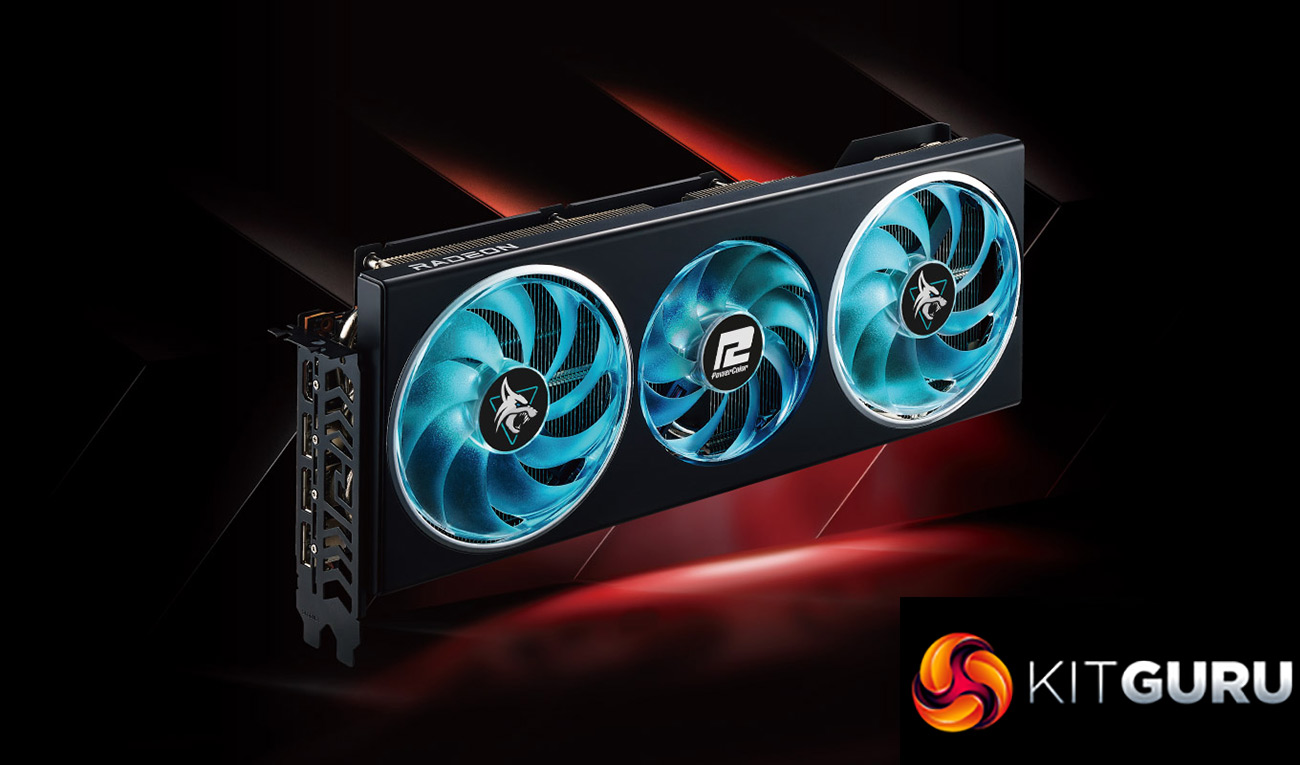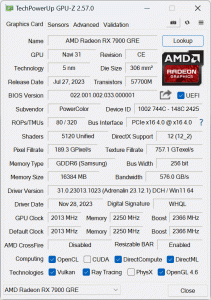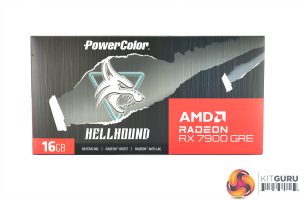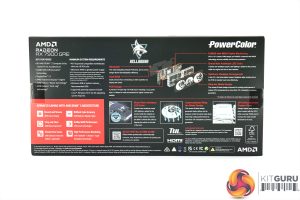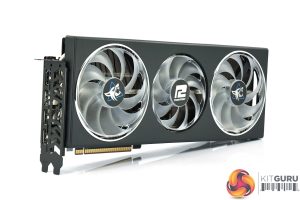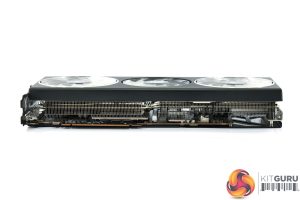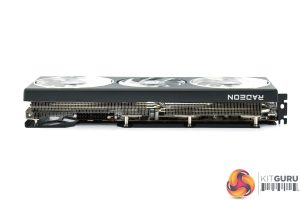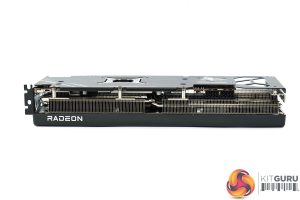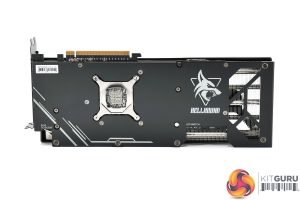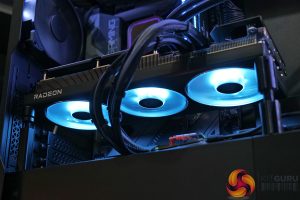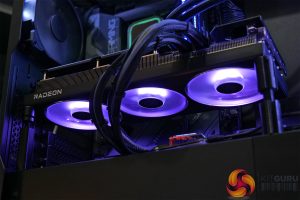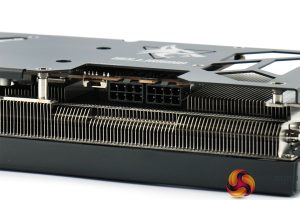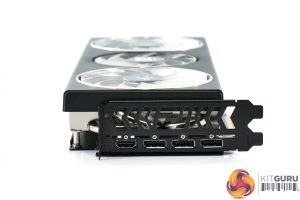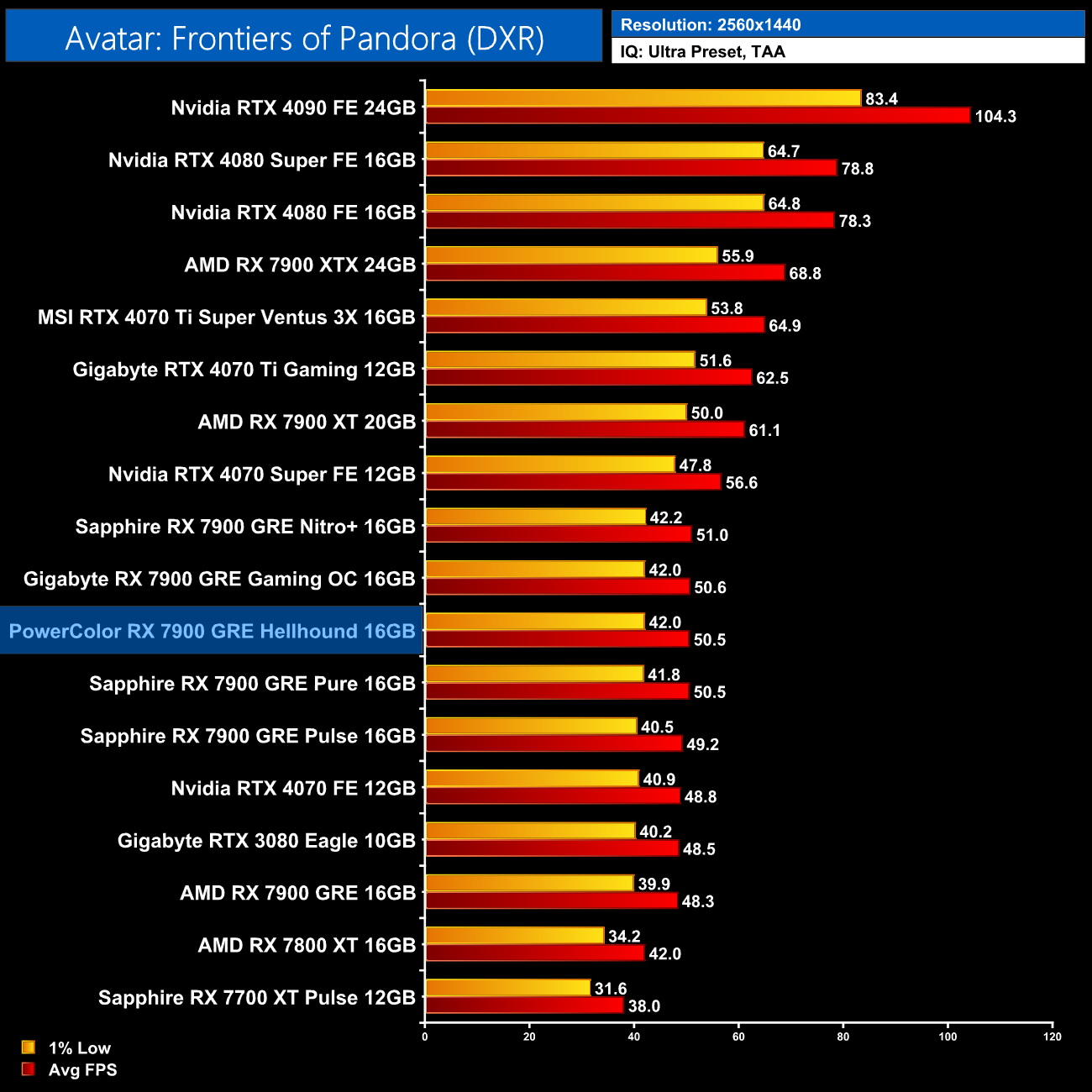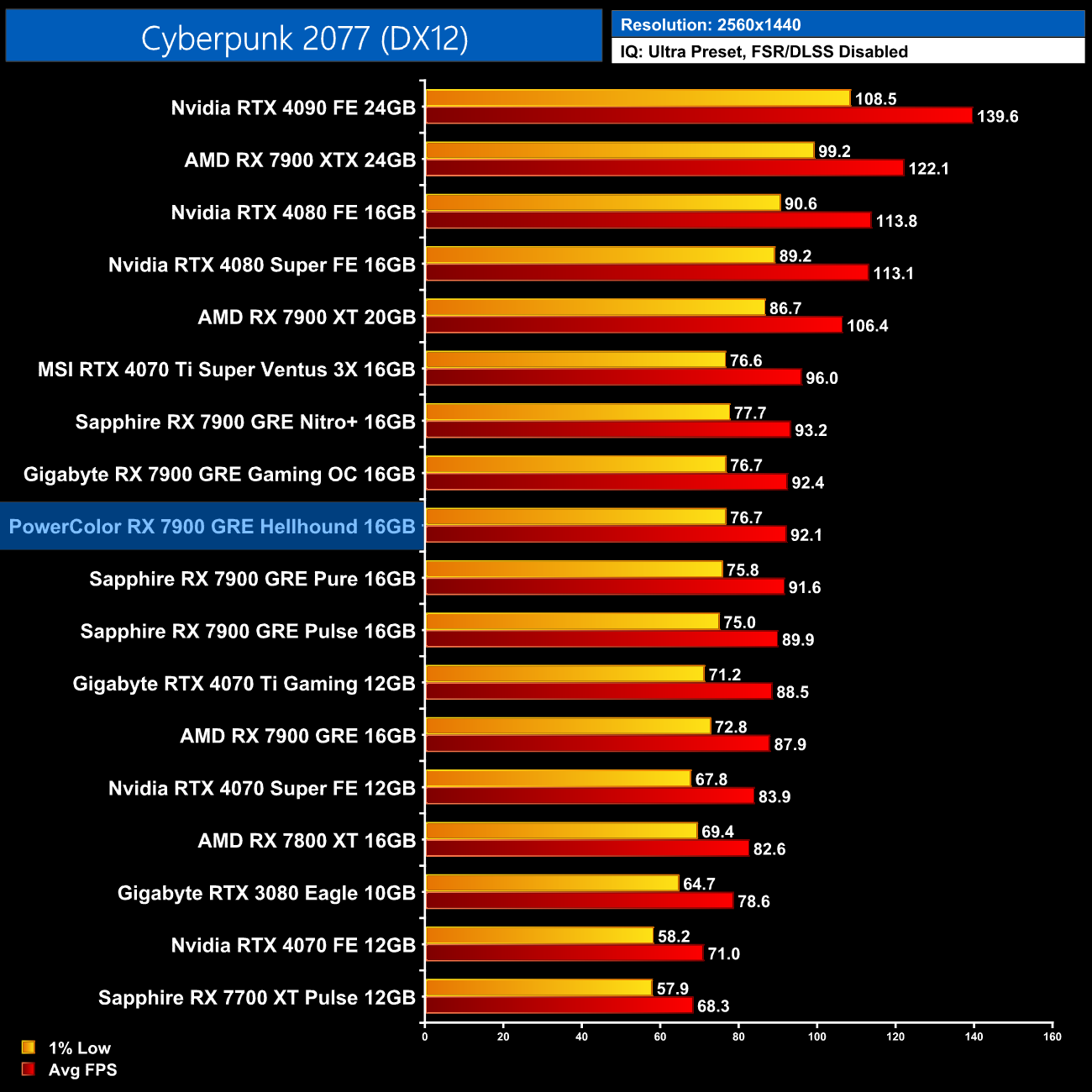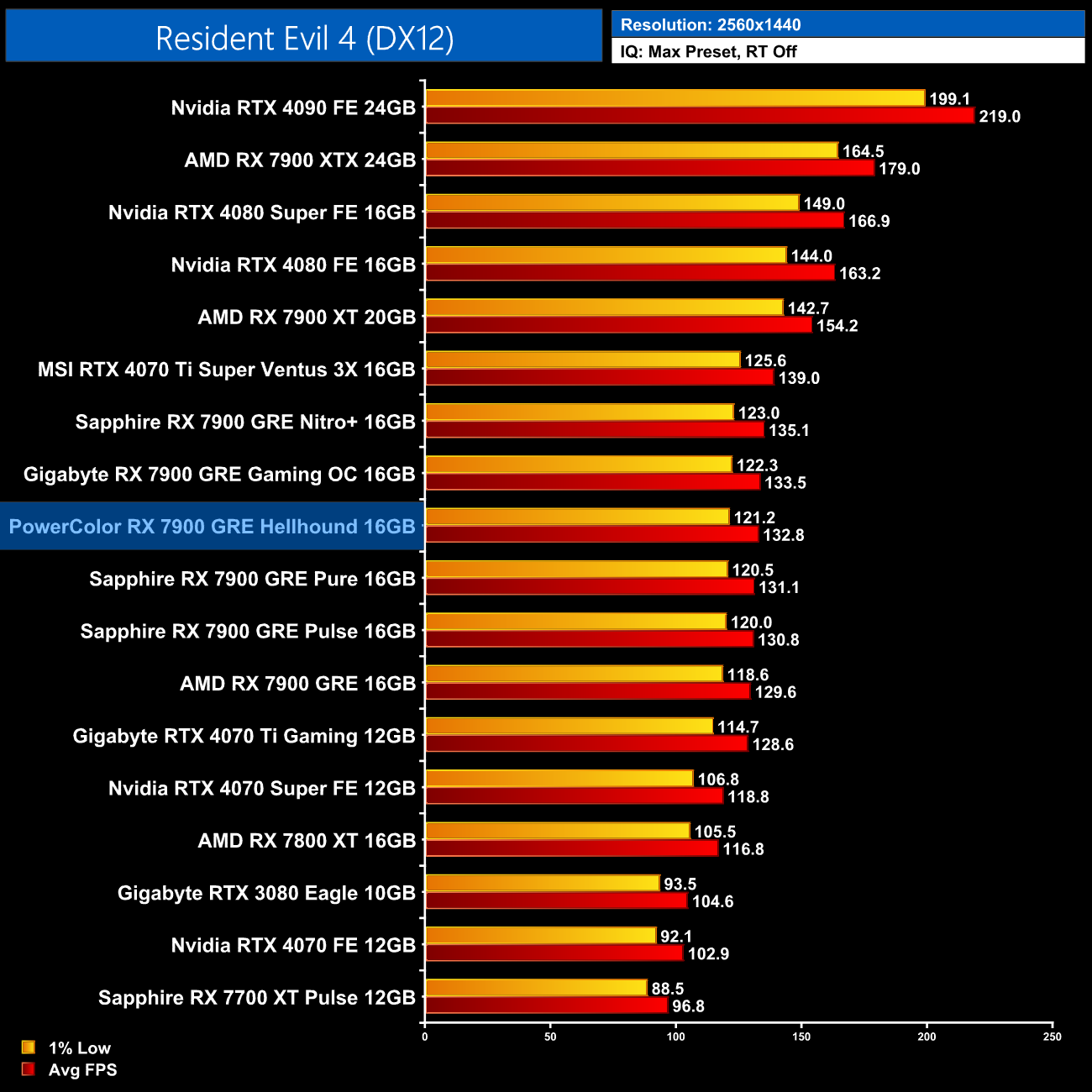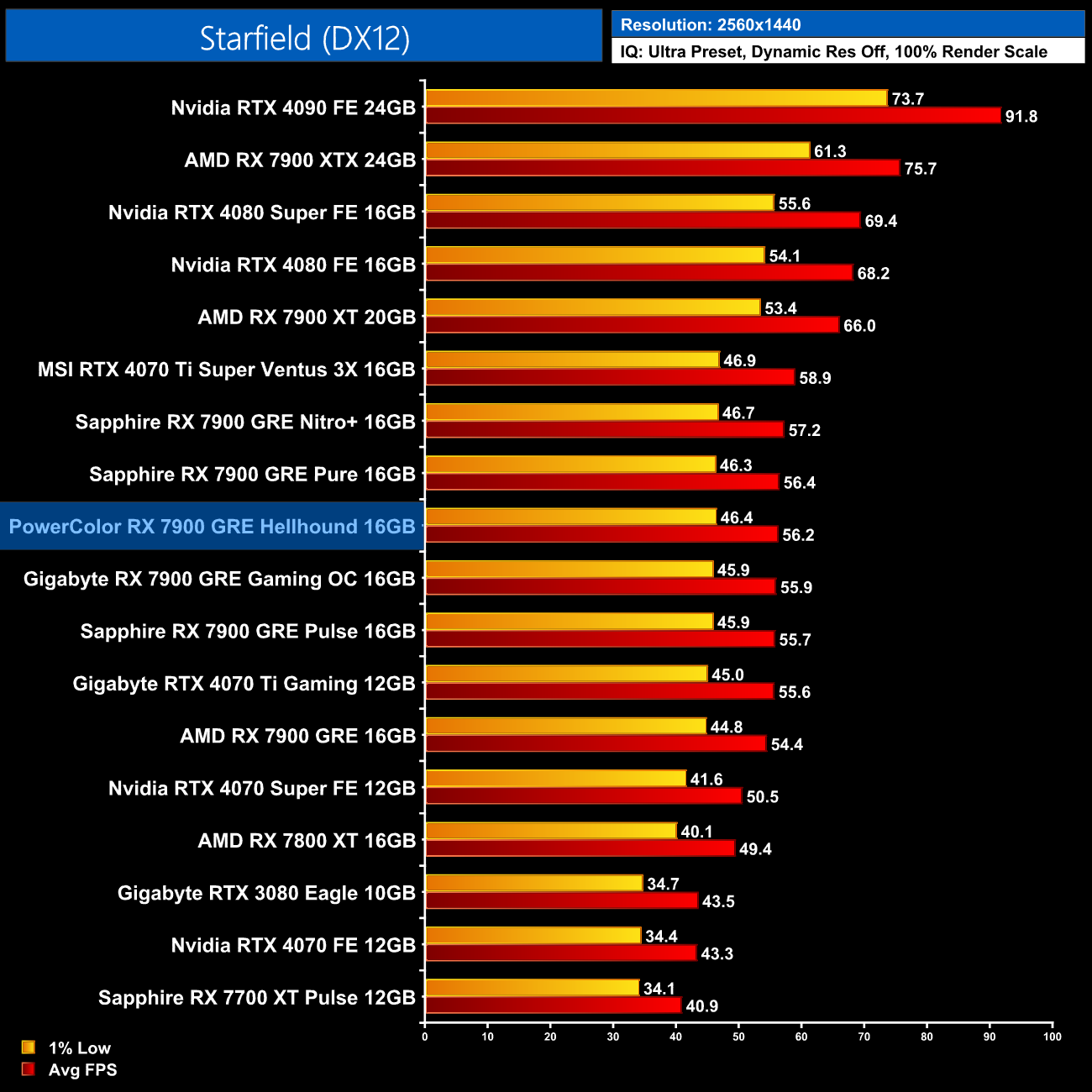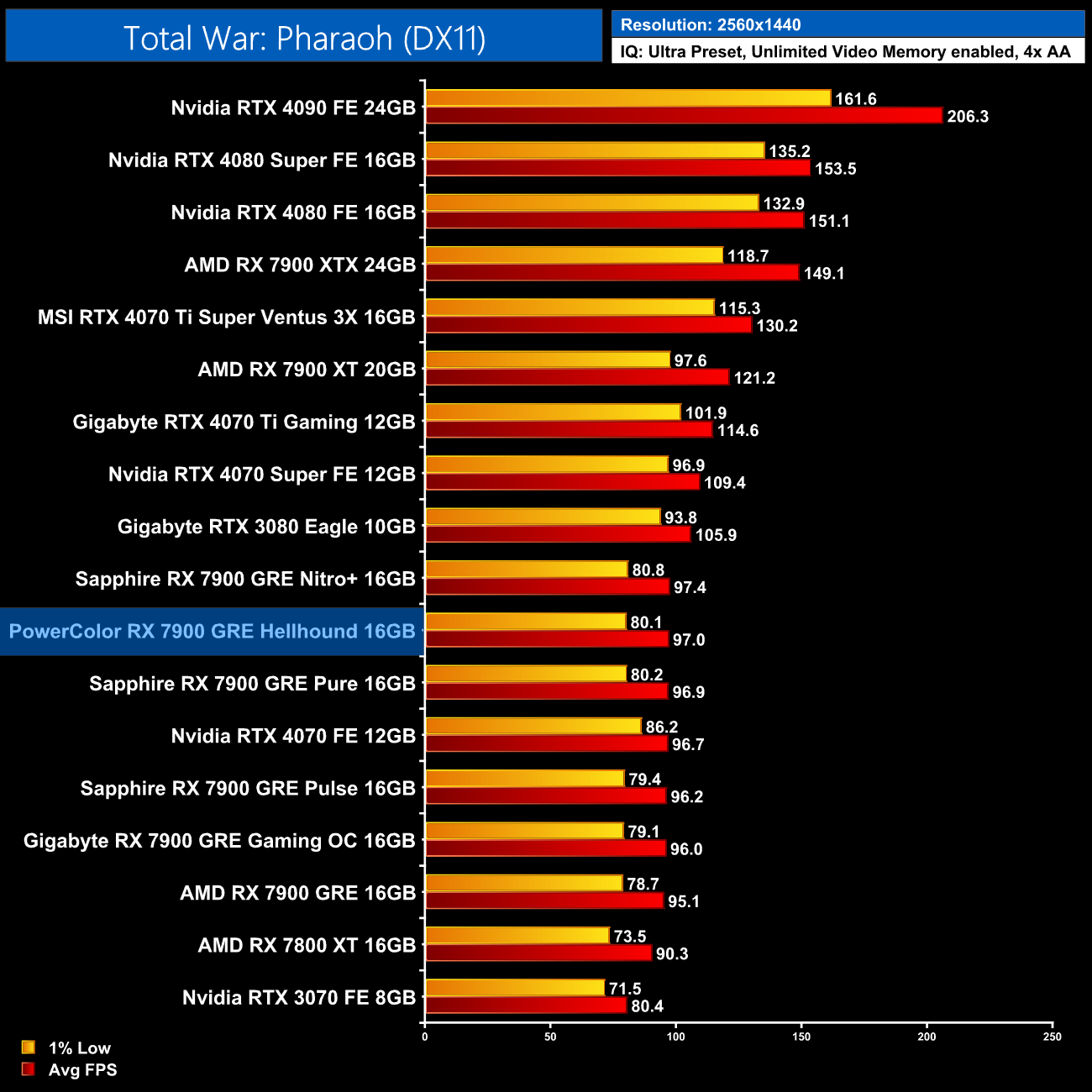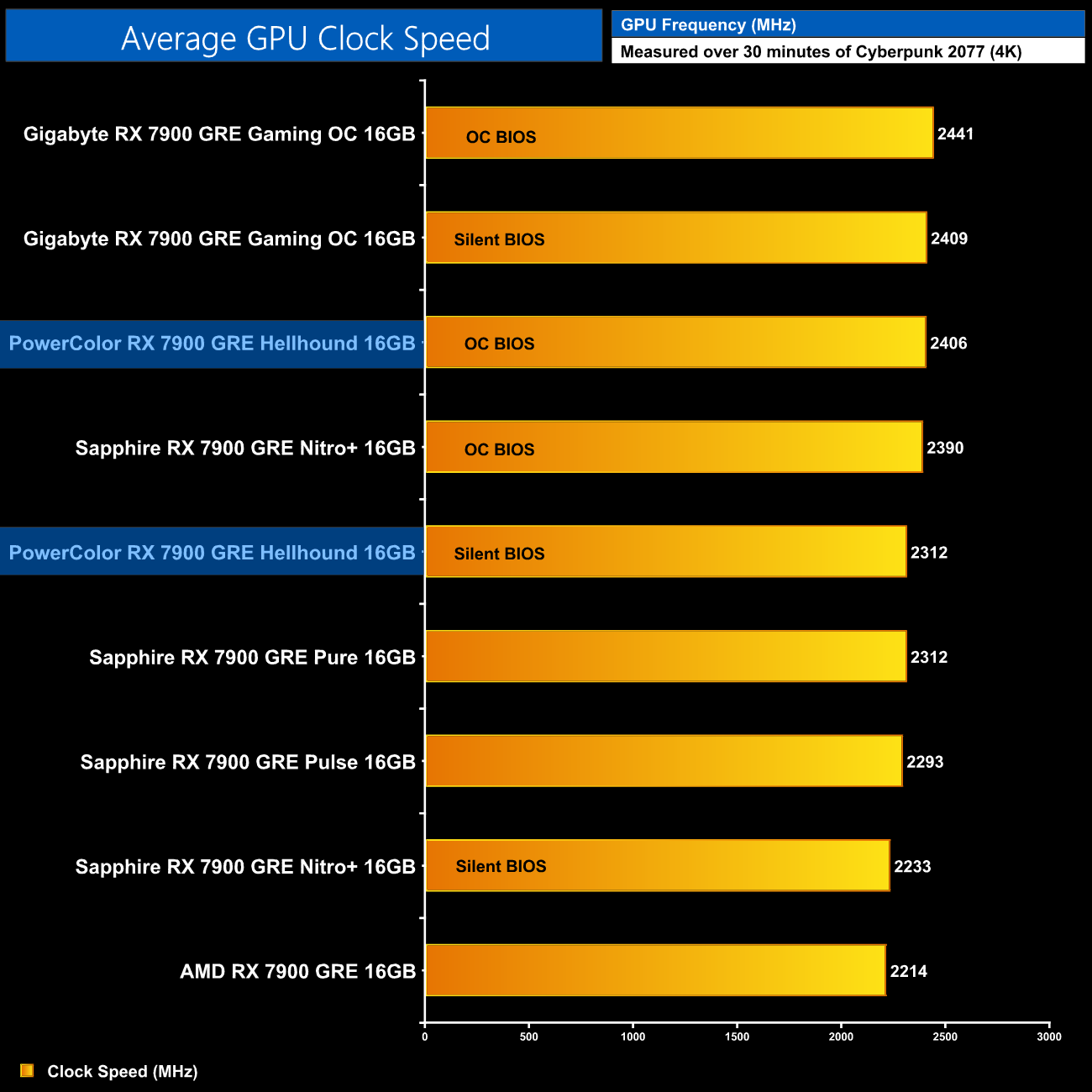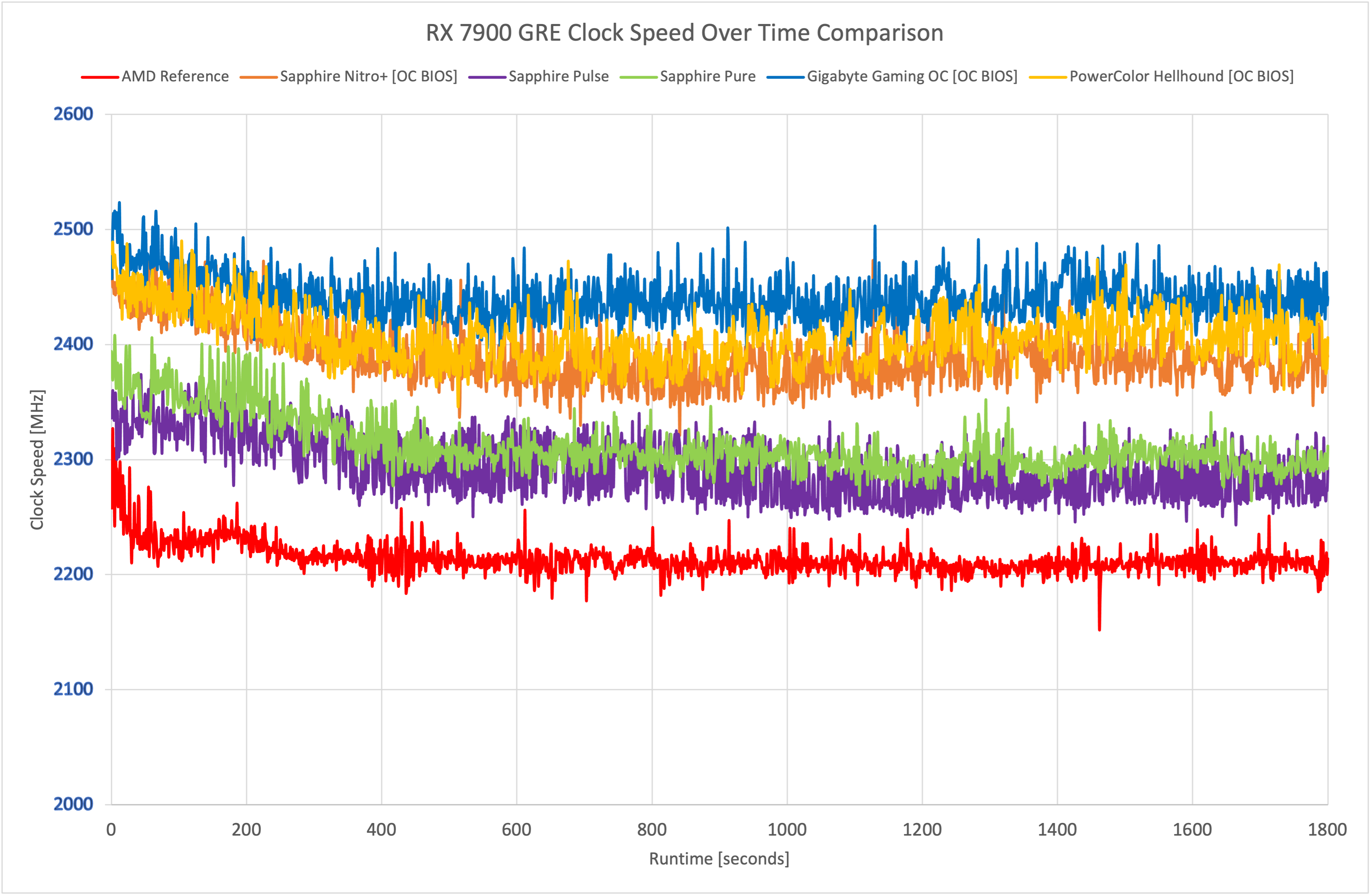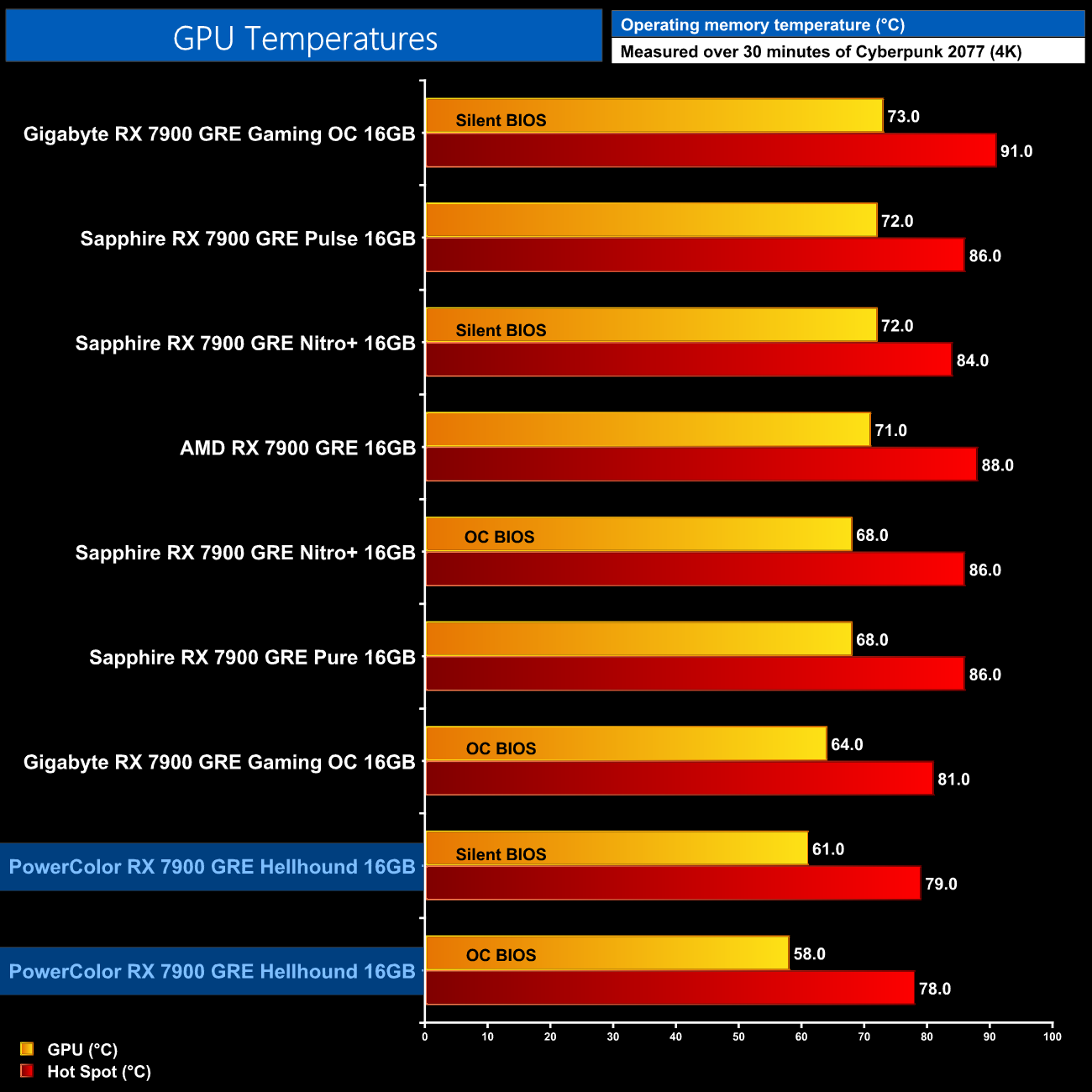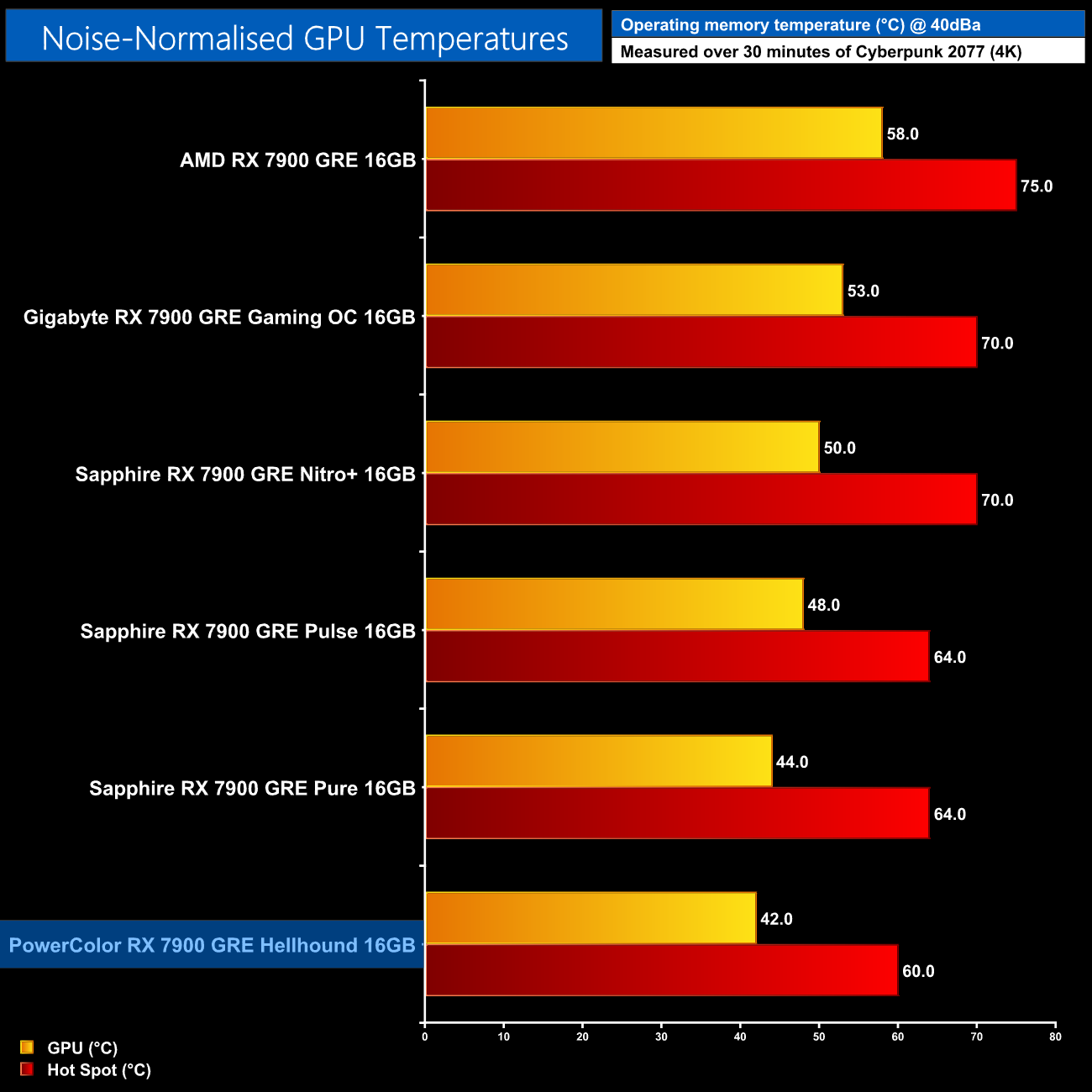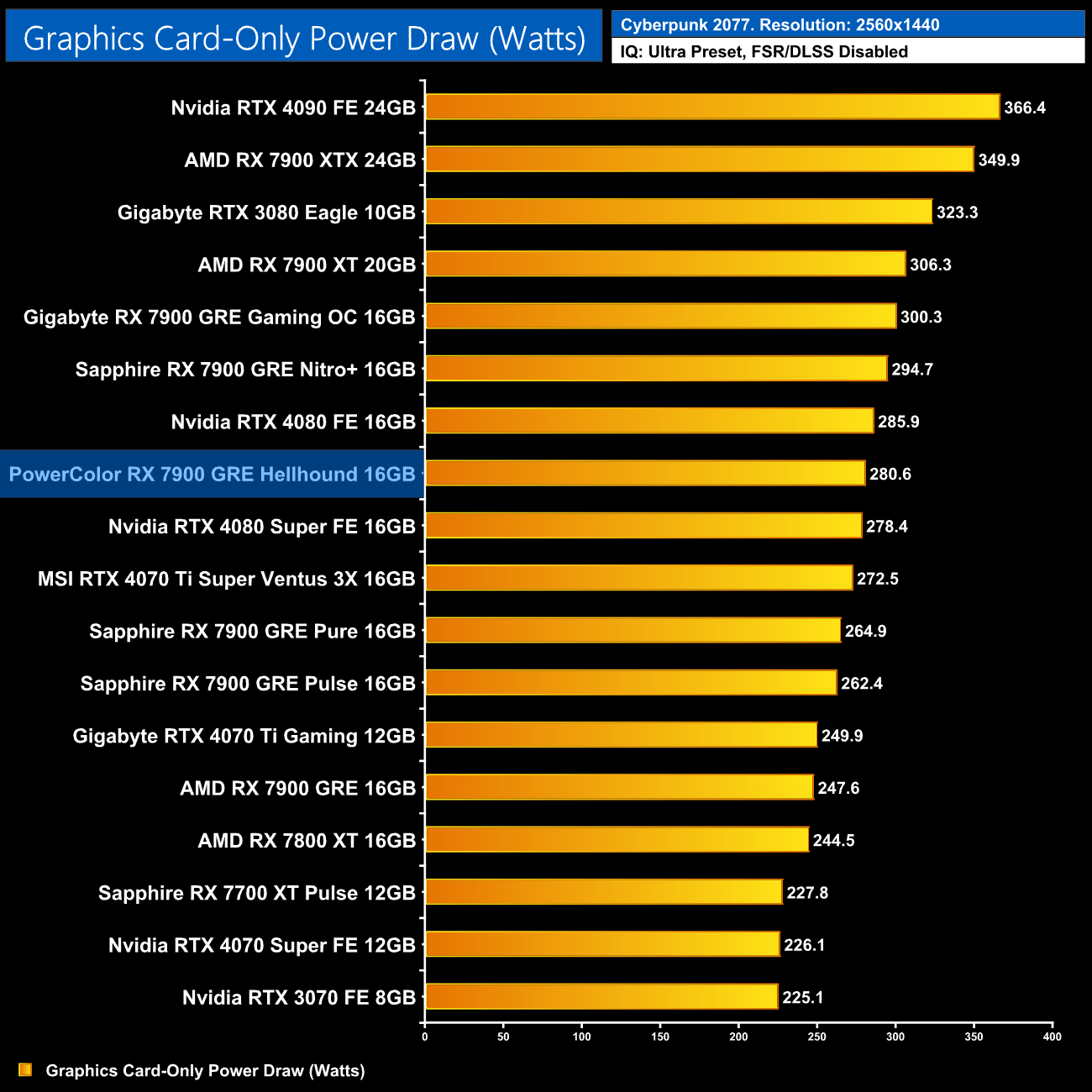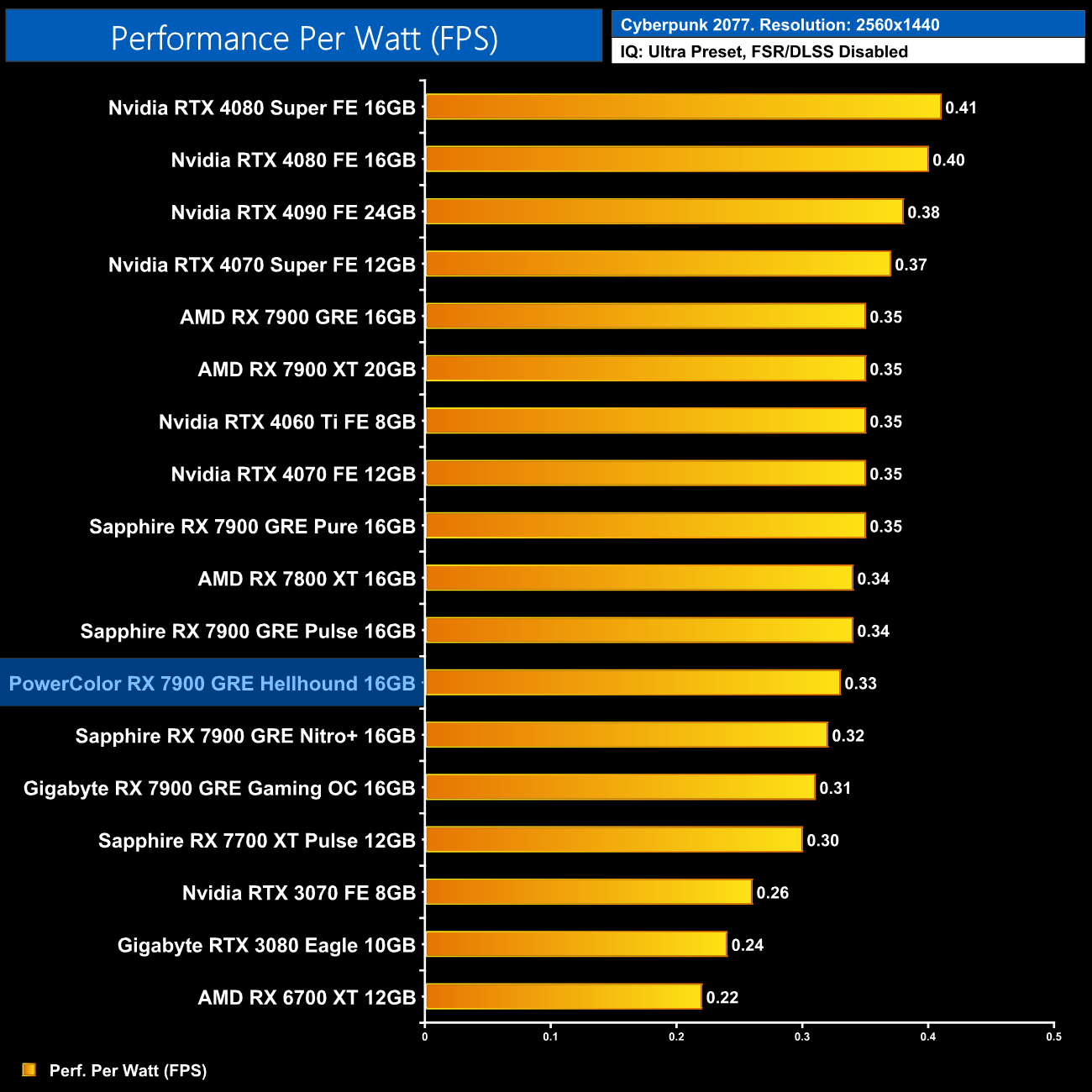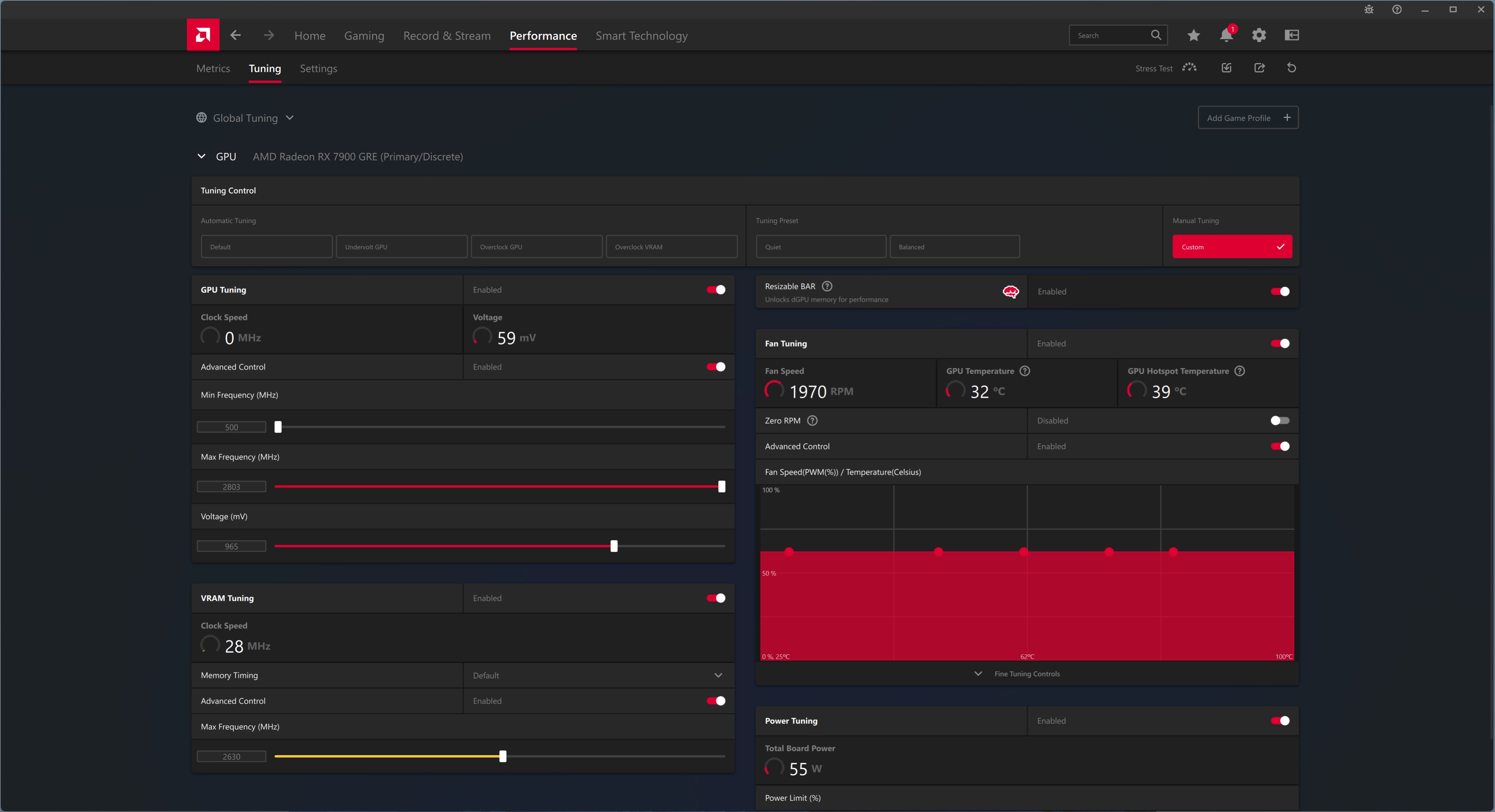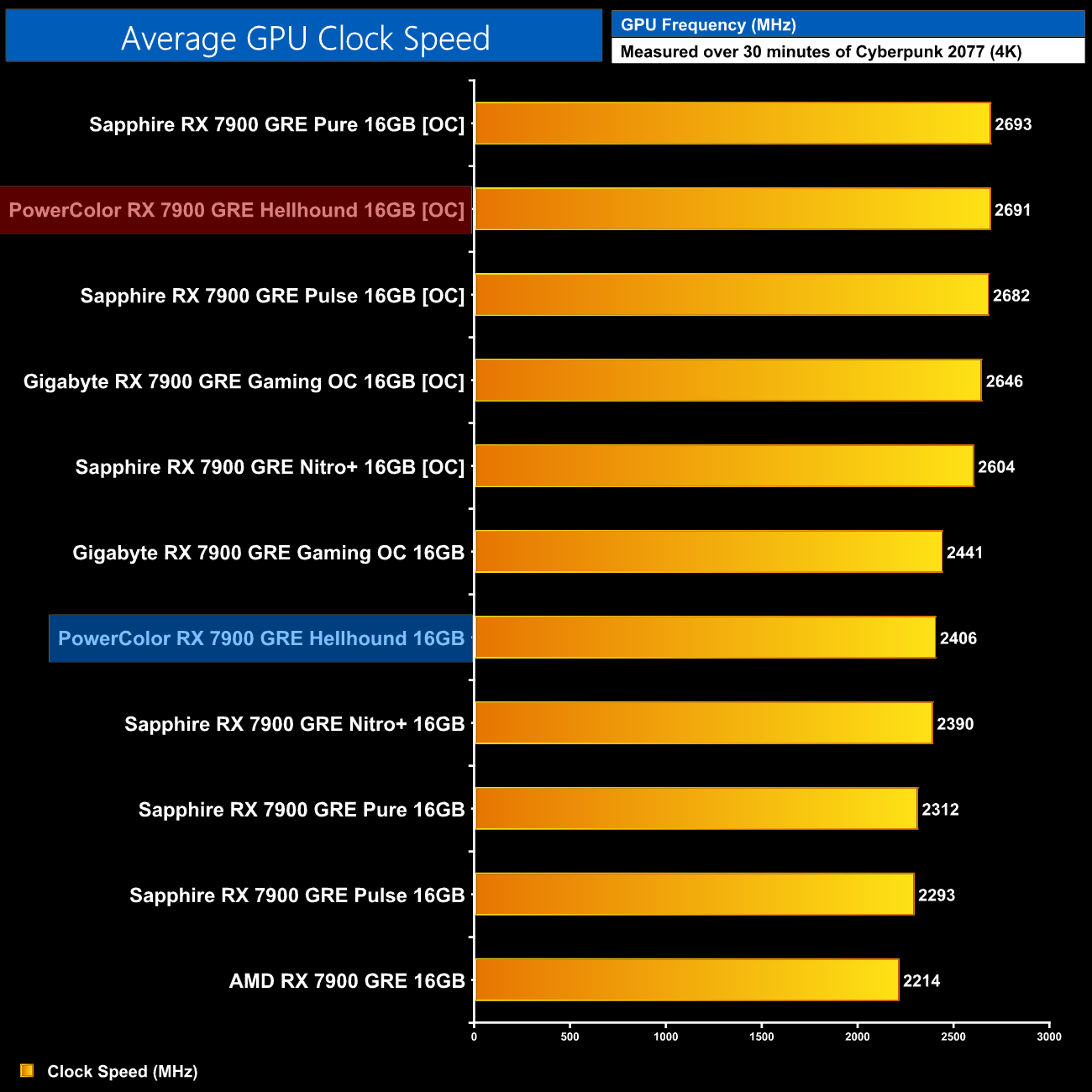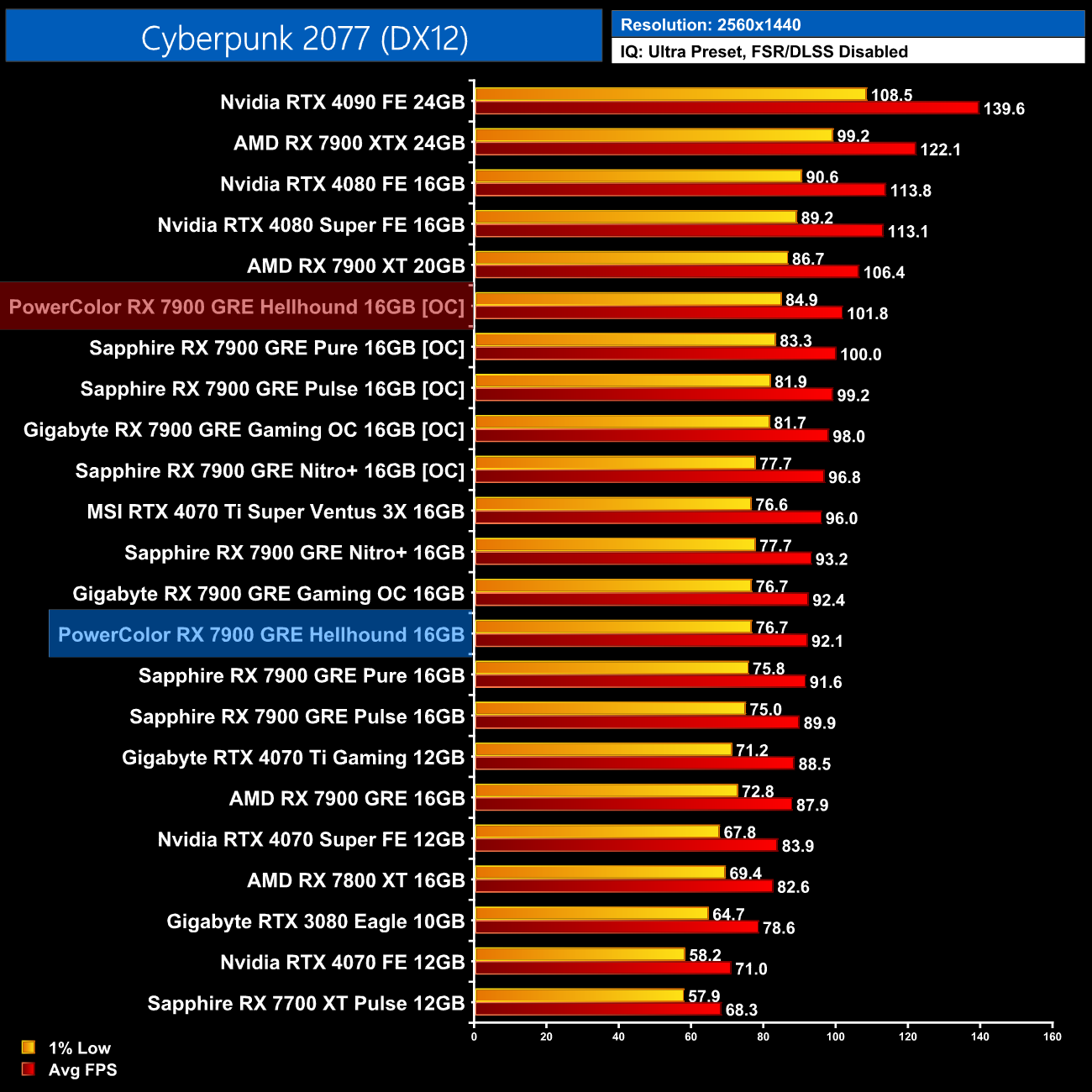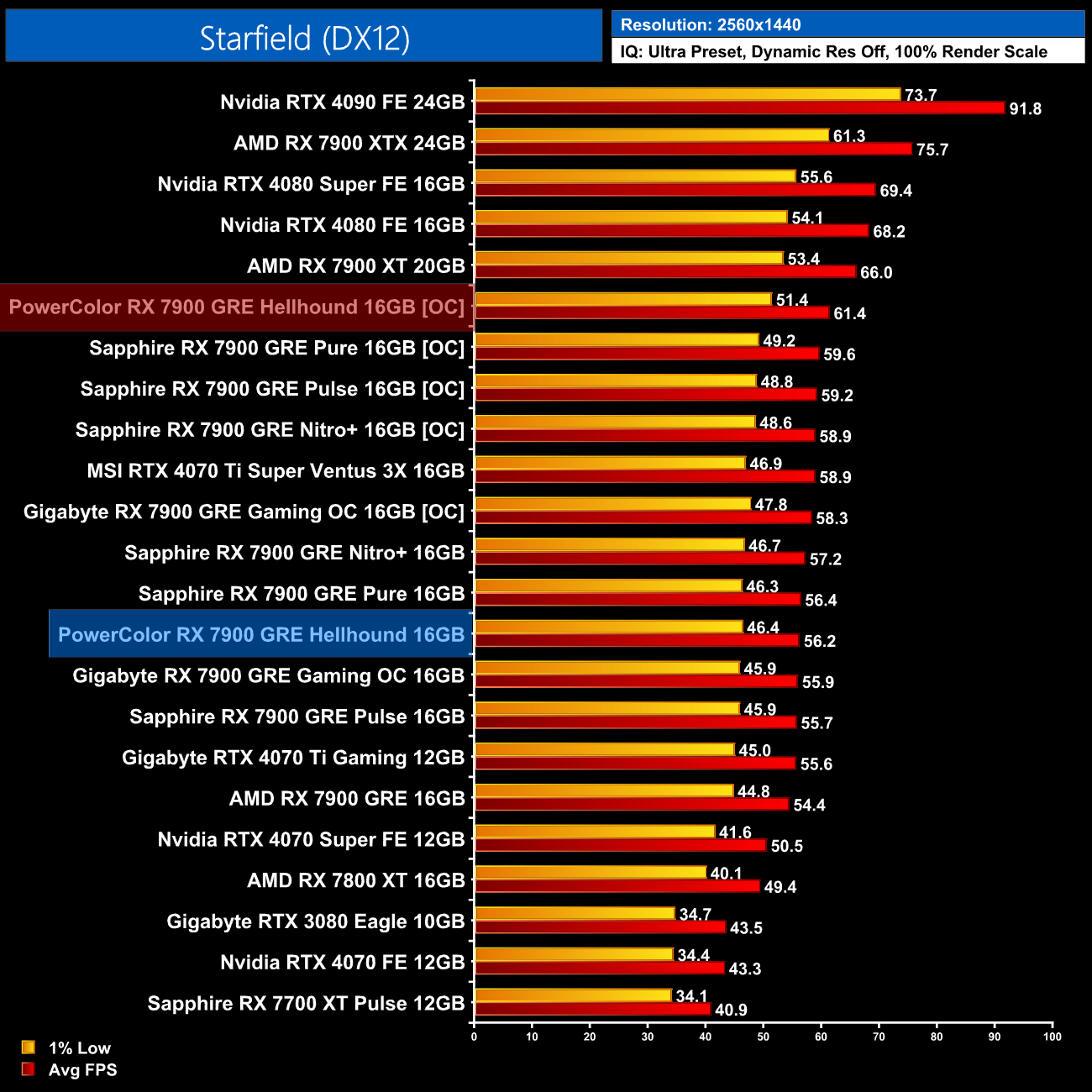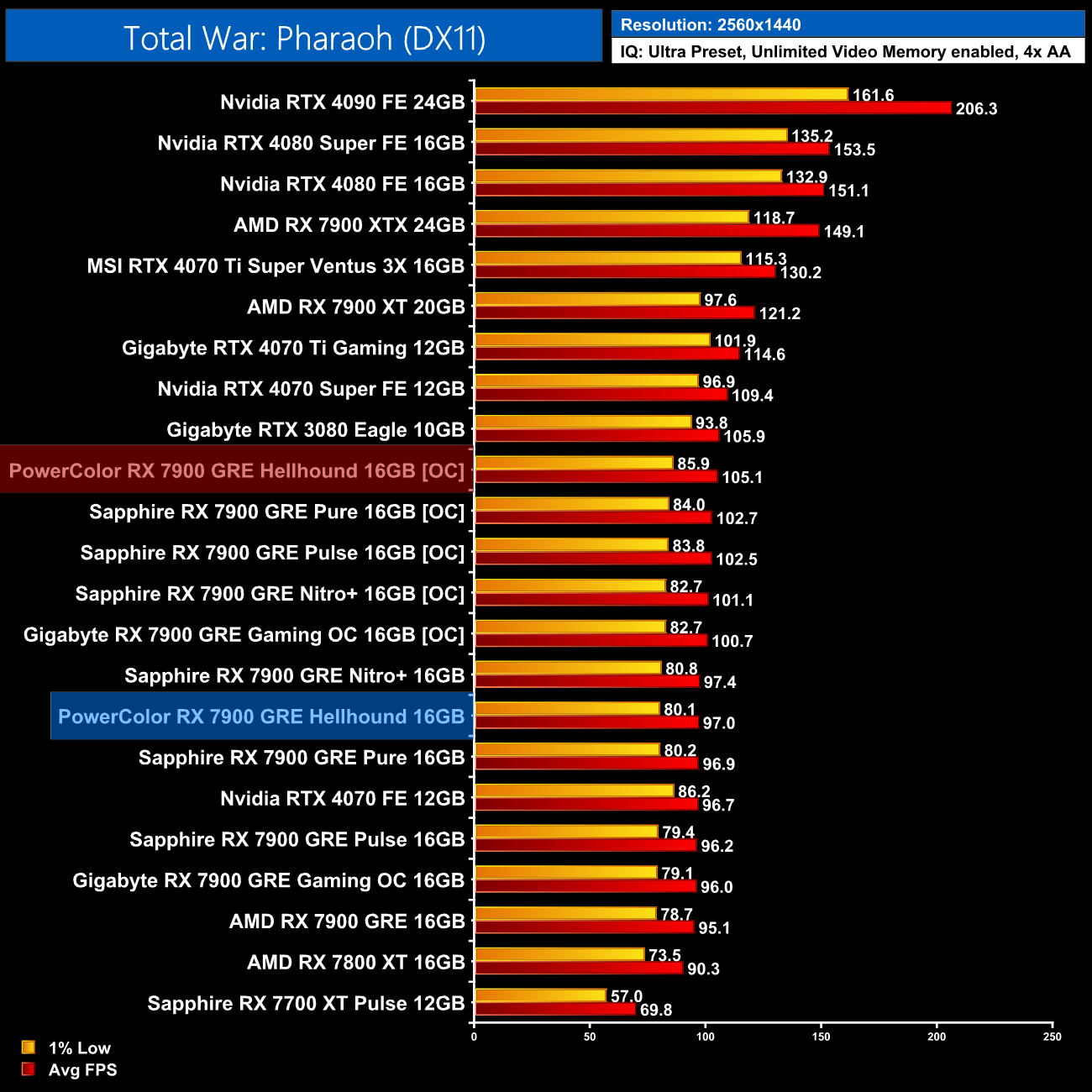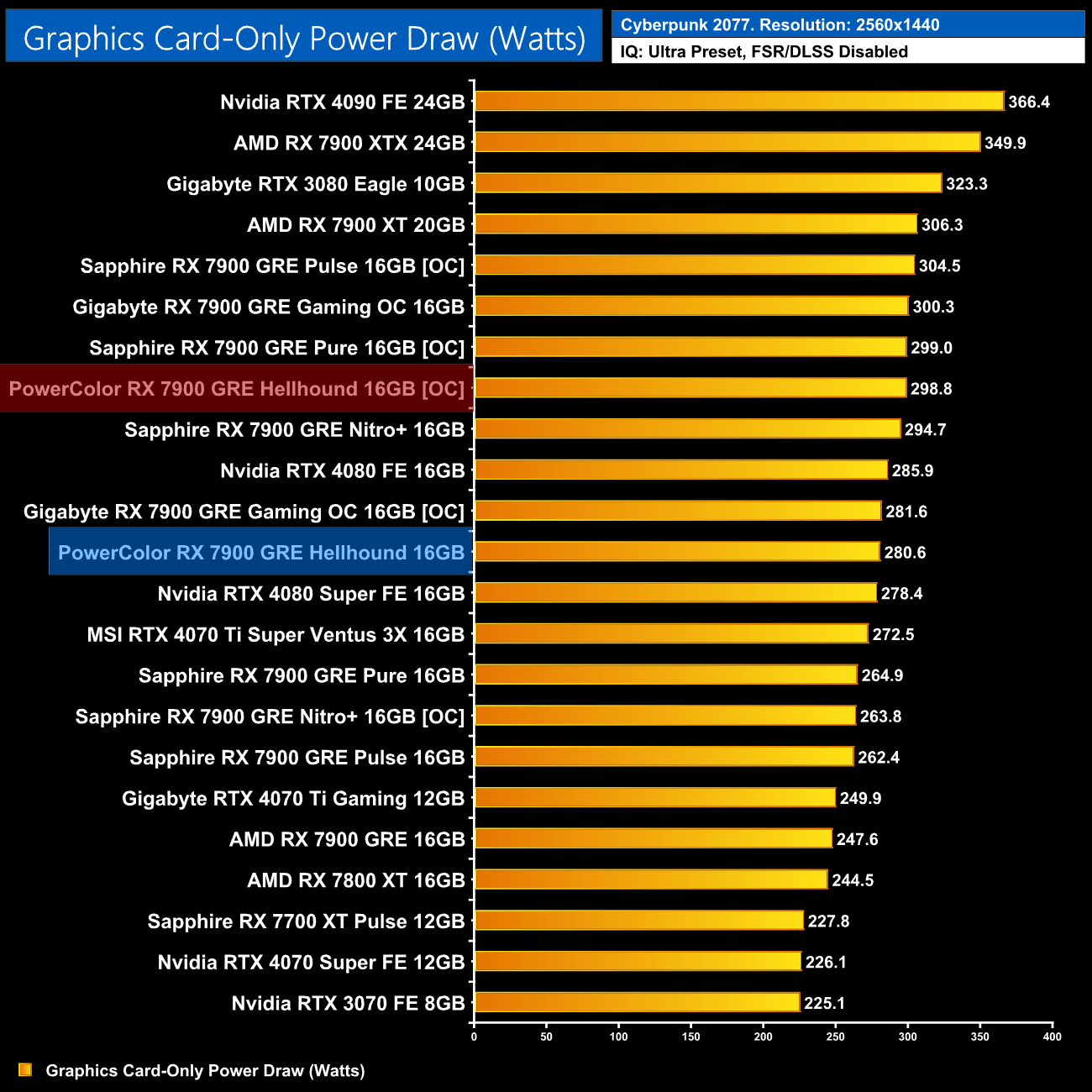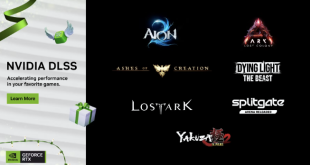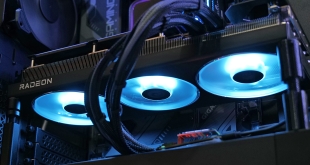
Today we are taking a look at a highly-requested graphics card – the PowerColor RX 7900 GRE Hellhound. It's been some time since we last looked at one of these GPUs, and with the Hellhound available at £549, it will be interesting to see how it stacks up not only against other 7900 GRE models, but also against Nvidia's RTX 4070 Super. We assess thermals, noise levels, gaming performance, power draw and more to find out if this card is worth buying.
| RX 7900 XTX | RX 7900 XT | RX 7900 GRE | RX 7800 XT | RX 7700 XT | |
| Architecture | RDNA 3 | RDNA 3 | RDNA 3 | RDNA 3 | RDNA 3 |
| Manufacturing Process | 5nm GCD + 6nm MCD | 5nm GCD + 6nm MCD | 5nm GCD + 6nm MCD | 5nm GCD + 6nm MCD | 5nm GCD + 6nm MCD |
| Transistor Count | 57.7 billion | 57.7 billion | 57.7 billion | 28.1 billion | 28.1 billion |
| Die Size | 300 mm² GCD
220 mm² MCD |
300 mm² GCD
220 mm² MCD |
300 mm² GCD
220 mm² MCD |
200 mm² GCD
150 mm² MCD |
200 mm² GCD
150 mm² MCD |
| Compute Units | 96 | 84 | 80 | 60 | 54 |
| Ray Accelerators | 96 | 84 | 80 | 60 | 54 |
| Stream Processors | 6144 | 5376 | 5120 | 3840 | 3456 |
| Game GPU Clock | Up to 2300MHz | Up to 2000 MHz | 1880 MHz | 2124 MHz | 2171 MHz |
| Boost GPU Clock | Up to 2500 MHz | Up to 2400 MHz | Up to 2245 MHz | Up to 2430 MHz | Up to 2544 MHz |
| ROPs | 192 | 192 | 192 | 96 | 96 |
| AMD Infinity Cache | 96MB | 80MB | 64MB | 64MB | 48MB |
| Memory | 24GB GDDR6 | 20GB GDDR6 | 16GB GDDR6 | 16GB GDDR6 | 12GB GDDR6 |
| Memory Data Rate | 20 Gbps | 20 Gbps | 18 Gbps | 19.5 Gbps | 18 Gbps |
| Memory Bandwidth | 960 GB/s | 800 GB/s | 576 GB/s | 624 GB/s | 432 GB/s |
| Memory Interface | 384-bit | 320-bit | 256-bit | 256-bit | 192-bit |
| Board Power | 355W | 315W | 260 W | 263W | 245W |
First, let's take a quick look at the specs. The RX 7900 GRE is using the same Navi 31 die that we first saw with the RX 7900 XTX and 7900 XT, but it has been significantly cut-down. Still, using the same die means we find a 300mm² Graphics Compute Die, based on TSMC's 5nm node, flanked by six 37mm² Memory Cache Dies (though two are disabled for the 7900 GRE). In total, the Navi 31 GPU packs 57.7 billion transistors.
While a full Navi 31 GPU packs in 96 Compute Units, the 7900 GRE is cut down to 80 CUs, 4 fewer than the 7900 XT, and each CU houses 64 Steam Processors, for a total of 5120 shaders. There's also 80 Ray Accelerators – one per CU – and 192 ROPs.
As for clock speed, AMD has de-coupled the clocks, so the front-end and shaders can operate at different clock speeds in a bid to save power. With the RX 7900 GRE, the Hellhound does come factory overclocked, with a boost at 2366MHz when using the OC BIOS.
The memory configuration is where we see the biggest change compared to the 7900 XT, however. With two of the six MCDs disabled, the RX 7900 GRE packs 16GB of GDDR6 memory clocked at 18Gbps, operating over a 256-bit memory interface, for total memory bandwidth of 576 GB/s. 64MB of Infinity Cache is also present, which allows AMD to claim an ‘effective memory bandwidth' of up to 2265.6 GB/s.
Power draw for the RX 7900 GRE is also rated at 260W Total Board Power (TBP), but the Hellhound has increased this up to 280W.
The PowerColor RX 7900 GRE Hellhound ships in a black box, with the Hellhound logo slap bang in the middle and AMD Radeon branding positioned in the bottom left corner. On the back, PowerColor highlights various key features of the card, as well as system minimum requirements.
Interestingly, there are no included accessories or quick start guides in the box.
As for the card itself, if you saw our review of the 7800 XT Hellhound, you will be instantly familiar with the 7900 GRE model, as it's exactly the same design. That means it's a relatively simple-looking card, but it still looks relatively sleek and appealing. The shroud is made of dark grey plastic and doesn't feature any raised sections or sharp angles, giving it a fairly stripped-back appearance that I think works well.
The three fans grab your attention, too, with their translucent fan blades, designed to amplify the LED lighting (as shown below). Interestingly, the central fan is smaller than the outer two at 90mm, while the others measure 100mm across. The central fan also spins in reverse, a now-common feature designed to reduce airflow turbulence.
Dimensions are the exact same as the 7800 XT model, too, measuring in at 322 mm x134 mm x 50 mm. It's not small, but it's funny how a 2.5 slot card looks relatively thin nowadays! It weighed in at 1267g on my scales.
The front side of the card is left very open, allowing a good chunk of hot air to escape from the heatsink.
As for the backplate, this is made of metal and spans the length of the card, but with four small cut-outs towards the end to allow air to pass through the heatsink.
We can also note the dual-BIOS switch positioned next to the I/O bracket, giving users a choice of either the OC or Silent modes. The OC BIOS increases power, clocks and fan speed compared to Silent, but we test both later in this review.
There's another switch next to the power inputs, and this controls the LED lighting. You can either set it to Ice Blue, Amethyst Purple or completely off. I did question this choice in my 7800 XT review, but judging by the comments on our YouTube video, plenty of readers love the idea of a hassle-free way to control the LEDs, while no software is required either. I personally think RGB control would look even better, but I can see the appeal of this simpler approach.
Elsewhere, we find two 8-pin power connectors, while display outputs are standard, with 3x DisplayPort 2.1 and 1x HDMI 2.1.
Driver Notes
- AMD GPUs were benchmarked with the Adrenalin 23.12.1 driver.
- Nvidia GPUs (except RTX 4070 Super/RTX 4070 Ti Super) were benchmarked with the 546.33 driver.
- RTX 4070 Super was benchmarked with the 546.52 driver supplied to press.
- RTX 4070 Ti Super was benchmarked with the 551.15 driver supplied to press.
- RTX 4080 Super was benchmarked with the 551.22 driver supplied to press.
Results are only directly comparable where this exact configuration has been used.
Test System:
We test using a custom built system from PCSpecialist, based on Intel’s Rocket Lake platform. You can read more about this system HERE and configure your own PCSpecialist system HERE.
| CPU |
Intel Core i9-13900KS
|
| Motherboard |
Gigabyte Z790 Gaming X AX
|
| Memory |
32GB (2x16GB) Corsair Dominator Platinum RGB DDR5 6000MHz
|
| Graphics Card |
Varies
|
| SSD |
4TB Seagate Firecuda 530 Gen 4 PCIe NVMe
|
| Chassis | Corsair 5000D Airflow Tempered Glass Gaming Case |
| CPU Cooler |
Corsair iCUE H150i Elite RGB High Performance CPU Cooler
|
| Power Supply |
Corsair 1600W Pro Series Titanium AX1600i Digital Modular PSU
|
| Operating System |
Windows 11 23H2
|
| Monitor |
MSI MPG 321URX QD-OLED
|
| Resizable BAR |
Enabled for all supported GPUs
|
Comparison Graphics Cards List
- AMD RX 7900 XTX 24GB
- AMD RX 7900 XT 20GB
- AMD RX 7900 GRE 16GB
- Gigabyte RX 7900 GRE Gaming OC 16GB
- Sapphire RX 7900 GRE Nitro+ 16GB
- Sapphire RX 7900 GRE Pulse 16GB
- Sapphire RX 7900 GRE Pure 16GB
- AMD RX 7800 XT 16GB
- Sapphire RX 7700 XT Pulse 12GB
- AMD RX 6700 XT 12GB
- Nvidia RTX 4090 FE 24GB
- Nvidia RTX 4080 Super FE 16GB
- Nvidia RTX 4080 FE 16GB
- MSI RTX 4070 Ti Super Ventus 3X 16GB
- Gigabyte RTX 4070 Ti Gaming 12GB
- Nvidia RTX 4070 FE 12GB
- Nvidia RTX 4060 Ti FE 8GB
- Gigabyte RTX 3080 Eagle 10GB
- Nvidia RTX 3070 FE 8GB
All cards were tested at reference specifications.
Software and Games List
- 3DMark Fire Strike & Fire Strike Ultra (DX11 Synthetic)
- 3DMark Time Spy (DX12 Synthetic)
- 3DMark DirectX Raytracing feature test (DXR Synthetic)
- Alan Wake II (DX12)
- Assassin's Creed Mirage (DX12)
- Avatar: Frontiers of Pandora (DX12)
- Cyberpunk 2077 (DX12)
- F1 23 (DX12)
- Forza Horizon 5 (DX12)
- Hitman 3 (DX12)
- The Last of Us Part 1 (DX12)
- Marvel's Spider-Man Remastered (DX12)
- A Plague Tale: Requiem (DX12)
- Ratchet and Clank: Rift Apart (DX12)
- Red Dead Redemption 2 (DX12)
- Resident Evil 4 (DX12)
- Returnal (DX12)
- Shadow of the Tomb Raider (DX12)
- Starfield (DX12)
- Total War: Pharaoh (DX11)
We run each benchmark/game three times, and present mean averages in our graphs. We use FrameView to measure average frame rates as well as 1% low values (99th percentile) across our three runs.
Here we test five games, all at 2560×1440 resolution using maximum image quality settings.
We don't focus too heavily on game benchmarks in our partner cards reviews as performance doesn't tend to change a whole lot when compared to the reference models, or other AIB cards for that matter. In this case, the Hellhound typically slots between the Sapphire Pure and the Nitro+, so it is a few FPS faster than the reference model, but the differences aren't huge.
Here we present the average clock speed for each graphics card while running Cyberpunk 2077 for 30 minutes. We use GPU-Z to record the GPU core frequency during gameplay. We calculate the average core frequency during the 30 minute run to present here.
As we can see on the chart above, the Hellhound clocks relatively high for a 7900 GRE, averaging 2406MHz over our thirty minute stress test – so it's almost 200MHz faster than the reference model.
For our temperature testing, we measure the peak GPU core temperature under load. A reading under load comes from running Cyberpunk 2077 for 30 minutes.
It's great to see terrific out of the box temperatures from the Hellhound – regardless of which BIOS you choose, these are class-leading results.
We take our noise measurements with the sound meter positioned 1 foot from the graphics card. I measured the noise floor to be 32 dBA, thus anything above this level can be attributed to the graphics cards. The power supply is passive for the entire power output range we tested all graphics cards in, while all CPU and system fans were disabled. A reading under load comes from running Cyberpunk 2077 for 30 minutes.
Making the out of the box thermal performance even more impressive is the fact that the Hellhound is simply incredibly quiet. My testing environment has a 32dBa noise floor, meaning the Silent BIOS was effectively inaudible, and the OC BIOS only registered at 33dBa on my sound meter. It would be basically impossible to hear the fans spinning over a typical case fan.
Following on from our stock thermal and acoustic testing, here we re-test the operating temperature of the GPU, but with noise levels normalised to 40dBa. This allows us to measure the efficiency of the overall cooling solution at varying noise levels as a result of more aggressive fan curves no longer being a factor.
We then increased fan speed until we hit 40dBa noise, and re-tested thermals. It's not a surprise to see the Hellhound running the coolest of the bunch, with a hot spot that's 4C lower than the Sapphire Pure.
It's also worth bearing in mind that this test does not take into account the power difference between the cards, and as we will see on the next page, the Hellhound also pulls more power than all but the Nitro+, making this result even more impressive.
We use Nvidia PCAT to measure power draw of the graphics card only, with readings from both the PCIe slot and the PCIe power cables combined into a single figure. We use Cyberpunk 2077 (1440p) for this testing.
Power draw is higher than all the 7900 GRE cards we've tested, with the exception of the Nitro+, given the Hellhound hit 280.6W.
Combining the power draw values shown above with the performance data, we present performance per Watt for each graphics card tested:
That does mean efficiency is reduced compared to the reference model, but not in a significant way.
For our manual overclocking tests, we used AMD's Adrenalin software. Our best results are as below.
When we first tested the 7900 GRE, AMD had locked the memory slider at 2316MHz so overclocking was quite limited. However, subsequent driver revisions have allowed the memory to be increased to 3000MHz, and I found the Hellhound was stable up to 2630MHz. We also maximised the power and GPU clock speed sliders, while settling on a voltage of 965mV.
This saw the Hellhound run at just under 2.7GHz, closely matching the Sapphire Pure for clock speed.
While the extra memory headroom didn't result in much difference compared to the other AIB cards when overclocked, if we compare to a stock-clocked reference 7900 GRE, the overclocked Hellhound is able to run 8-15% faster depending on the game – so the gains looks quite reasonably in that regard!
Of course, power draw does increase when overclocking, and we saw the Hellhound pull just under 300W – which is about 50W more than the stock-clocked reference card.
Today we have turned out attention back to the AMD RX 7900 GRE with a review of the PowerColor Hellhound model – something we actually had quite a few requests for in our last 7900 GRE 4-way roundup.
As it turns out, the Hellhound is fitted with the best aftermarket cooler that we have seen from any 7900 GRE card, including the Sapphire Nitro+. Not only is it incredibly quiet out of the box, but it runs the coolest of any card we have tested so far. Its noise-normalised thermals also position it as the most efficient cooler design we have seen.
While gaming performance is very similar to the other models tested, it has been interesting to revisit overclocking today, given AMD unlocked the memory sliders since the GRE's initial launch. The gains versus other overclocked AIB models are only small, but the Hellhound was coming in anywhere from 8-15% faster than a stock-clocked reference 7900 GRE, so there is clearly a lot of scope to push this silicon with higher clock speed and power limits.
Currently priced at £549 here in the UK, of all the 7900 GRE cards I have looked at so far, I'd say the Hellhound would be my number one pick. As I discussed in my launch day review however, I am not convinced that the 7900 GRE should be your choice over the RTX 4070 Super. Yes, it does have an extra 4GB of VRAM, but the Nvidia GPU is significantly faster for ray tracing, offers DLSS support and is also a good chunk more efficient.
It's also now equivalently priced, with models now on sale in the UK for £540. For me, the 7900 GRE does need to be another £50 cheaper to have a fighting chance against the Nvidia GPU. As good as this PowerColor Hellhound model is, unless you really need that extra video memory, my recommendation would be for a 4070 Super instead – but let me know your thoughts in the comments below.
You can pickup the Hellhound 7900 GRE for £549 HERE.
Discuss on our Facebook page HERE.
Pros
- Slightly faster than the reference card.
- Best cooler of any 7900 GRE we have tested.
- Incredibly quiet out of the box.
- Relatively compact despite being a triple-fan cooler.
- Dual-BIOS.
- LED switch to easily control lighting.
- Overclocking the memory is no longer artificially limited.
Cons
- Some may wish it had RGB lighting.
- Significantly slower than the 4070 Super for ray tracing.
- RDNA 3 is less efficient than Ada Lovelace.
- RTX 4070 Super is now available for the same price.
KitGuru says: It's a cracking partner card, but as we've said all along, AMD needs to lower pricing to make the 7900 GRE more competitive with the RTX 4070 Super.
 KitGuru KitGuru.net – Tech News | Hardware News | Hardware Reviews | IOS | Mobile | Gaming | Graphics Cards
KitGuru KitGuru.net – Tech News | Hardware News | Hardware Reviews | IOS | Mobile | Gaming | Graphics Cards


